DAB + digital radio - how does it work and is it needed at all?
Hi, Habr.
In recent years, the introduction of the digital radio standard DAB + has been discussed in Russia, Ukraine and Belarus. And while in Russia the process has not yet advanced, in Ukraine and Belarus it seems that they have already switched to test broadcasting.
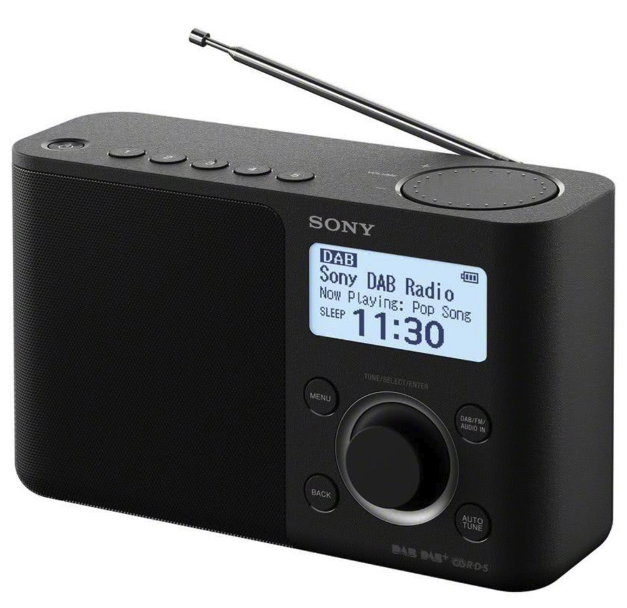
How does it work, what are the pros and cons, and is it needed at all? Details under the cut.
The idea of digital radio began to emerge in the late 80s, when it became clear that there was already not enough “place” in the usual FM band - in large cities the free spectrum in the 88-108 MHz band was exhausted. In this regard, DAB was considered a good alternative - it is a digital standard in which, due to more efficient coding, more stations can be placed. In the first version of DAB, the MP2 codec was used, in the second version (DAB +), the newer HE-AAC. The standard itself is very old by modern standards - the first DAB station was launched in 1995, and the DAB + station in 2007m. Moreover, the "age" of the standard in this case is even more likely plus than minus - now there is no problem buying a radio for every taste and budget.
There are quite a lot of differences between DAB and familiar FM. And the point is not that one is a “figure”, but the other is an “analogue”. The principle of content transfer is different. In FM, each station broadcasts independently, and in DAB + all stations are combined into a “multiplex”, each of which can have up to 16 stations. Different frequency channels are provided, so different countries may choose those that are free of other services.
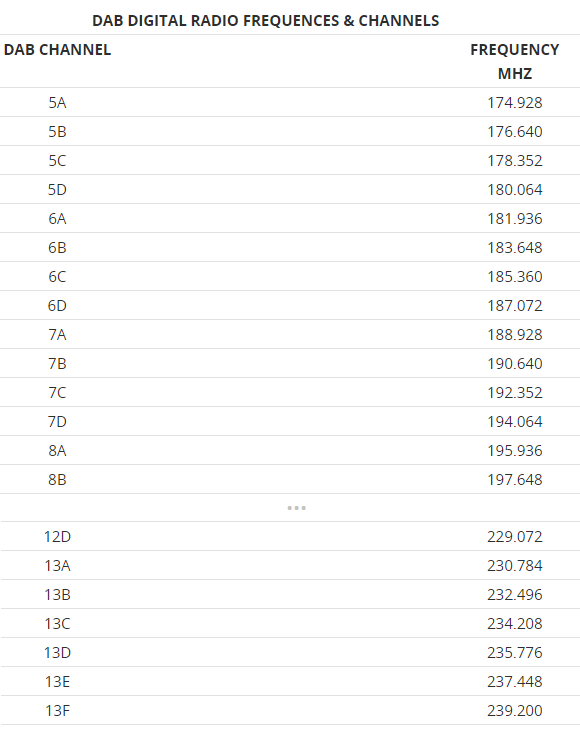
From a business point of view, this difference causes a series of controversy among broadcasters regarding how to broadcast in a multiplex. Previously, broadcasters themselves obtained a license for the frequency, bought an antenna and a transmitter, now the license will be issued to the multiplex operator, and it will already lease channels to radio stations. It’s hard to say whether it’s better or worse, it’s more convenient for someone to have all of their own, someone is more comfortable renting.
By the way, in this regard, DAB has a huge and fat minus for the listener - the price of renting a multiplex depends on the bitrate . And if you choose between 192 and 64kbps ... I think everyone understands what will be chosen. If broadcasting with poor quality in FM is rather difficult, then in DAB it is even encouraged economically (it is clear that this is not the fault of the developers of the standard, but nonetheless). Russian prices are, of course, unknown, and English for an example, you can see here .
From a technical point of view, the DAB + multiplex is a broadband signal with a spectrum width of the order of 1.5 MHz, which is clearly visible using an RTL-SDR receiver.
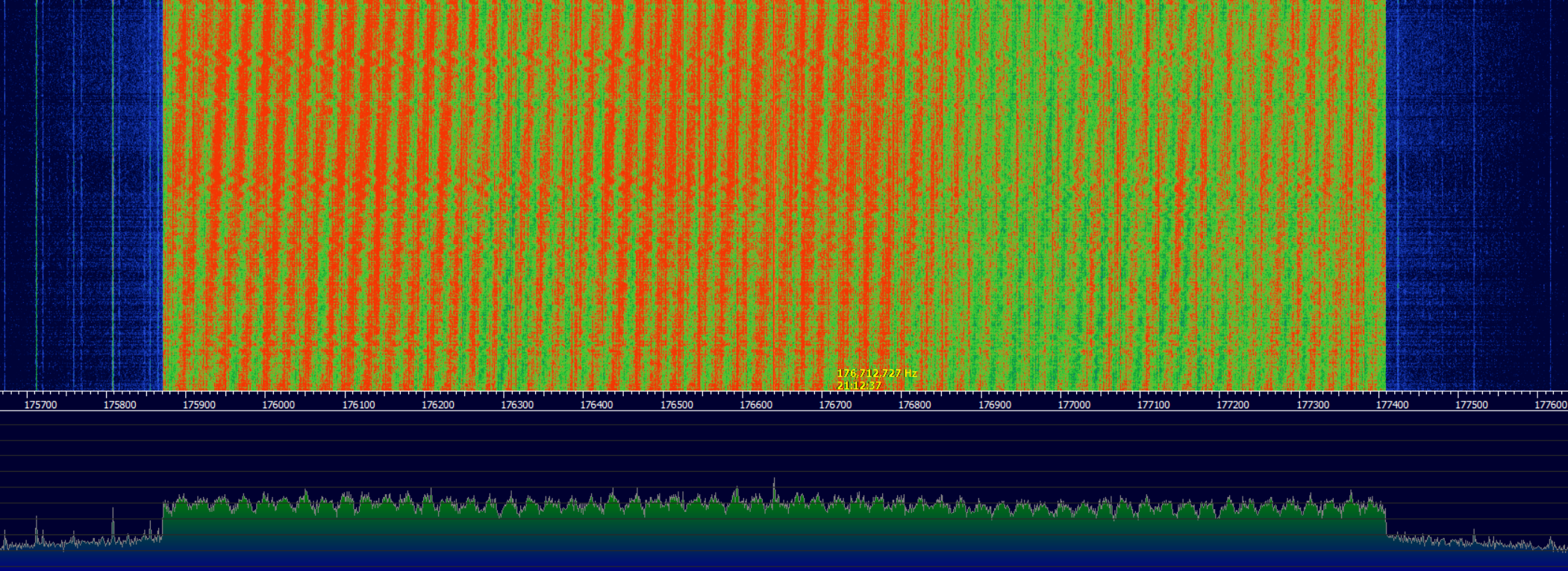
A more detailed description in PDF can be found here .
In general, there are not so many of them. In Europe, DAB + is used, in the USA the HD Radio standard is popular , in India they conducted experiments with the DRM standard , but it's hard to say how they ended.
The map is a bit outdated (DRM was also tested in Russia, but it was abandoned), but the general idea can be understood:
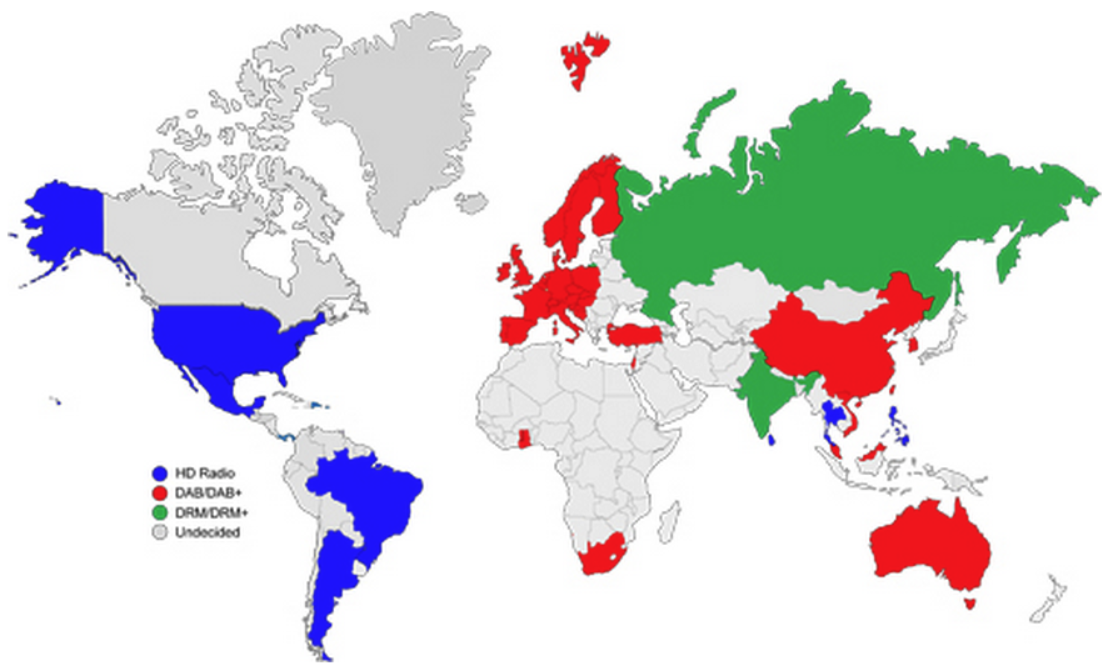
Source
Unlike DAB, the creators of the HD Radio standard took a different path - the digital signal is placed directly next to the analog one, which allows broadcasters to use their own antennas and masts.
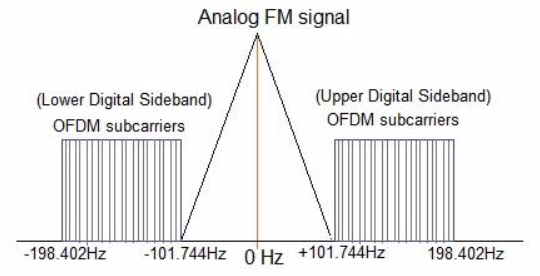
However, this does not solve the problem, because of which it all began - the problem of the lack of empty seats in the spectrum. Yes, and purely geographically (and probably politically), in ex-CIS countries, the adoption of a European standard looks more logical than using the American standard - the choice of European goods is still more and it is easier to buy receivers. In 2011, there were still references to the Russian RAVIS standard , but it all died out (and thank God, because its own digital standard is incompatible with anything, this is the worst that could have been invented for radio listeners).
Finally, we turn to the practical part, i.e. to testing. In Russia, DAB does not work yet, so we will use SDR records from the Dutch multiplex. Those interested from other countries can also join and send me records in IQ format, I will process them and make a summary table.
How can you listen to DAB at all? Because digital standard, then you can decode it using a computer and rtl-sdr receiver. There are two programs - qt-dab and Welle.io , both can work with rtl-sdr.
Qt-dab looks like a student’s term paper, and the author clearly didn’t bother with design - fonts do not fit into controls, windows do not scale. But for us, the most important thing is that it allows you to read and write IQ files.
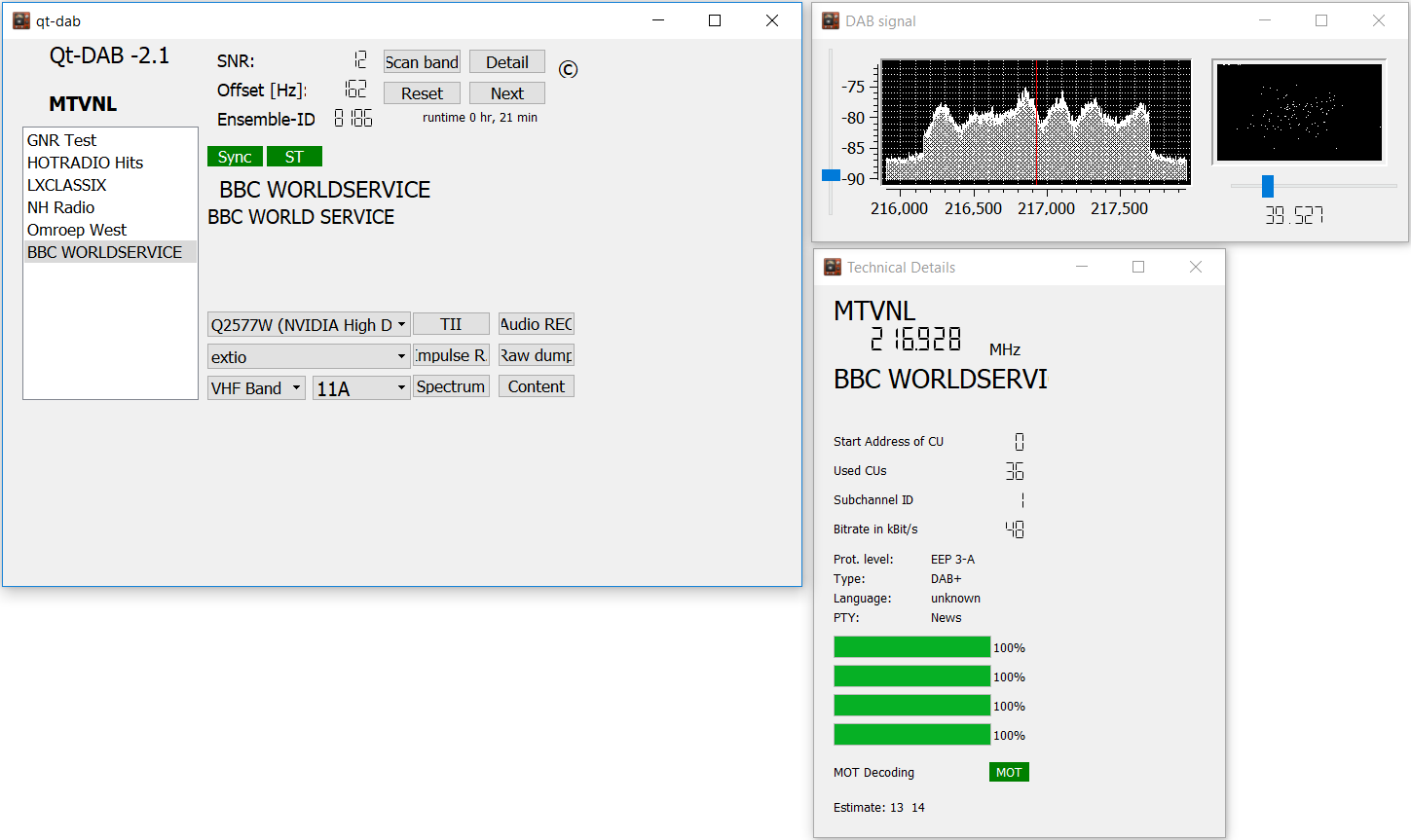
Welle.ioIt’s still in beta, but it works much better and decodes better. It is also possible to display quite a lot of additional debugging information:
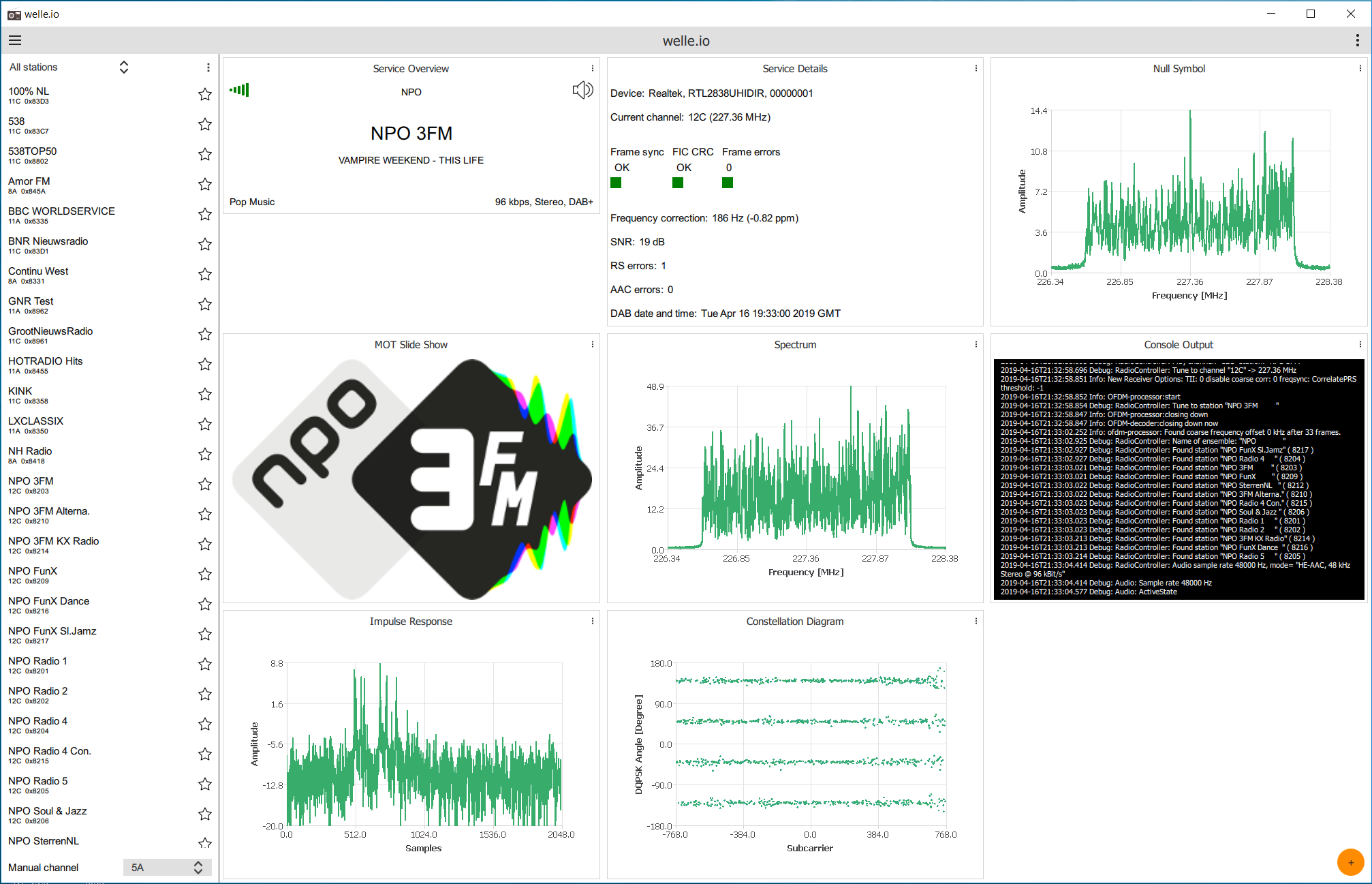
But welle.io is not yet able to work with iq-files, so we will use Qt-dab.
For testing, I uploaded 3 files to cloud.mail.ru, each one contains a minute record of the DAB multiplex, the file size is about 500 MB (this is the size of IQ records for SDR with a 2.4 MHz bandwidth). You can open files in Qt-dab, the download link of which is given above.
File-1 : DAB-8A.sdr - cloud.mail.ru/public/97hr/2QjuURtDq . Multiplex 8A operates at a frequency of 195.136 MHz and contains 16 stations. The bit rate of all stations is 64Kbps.
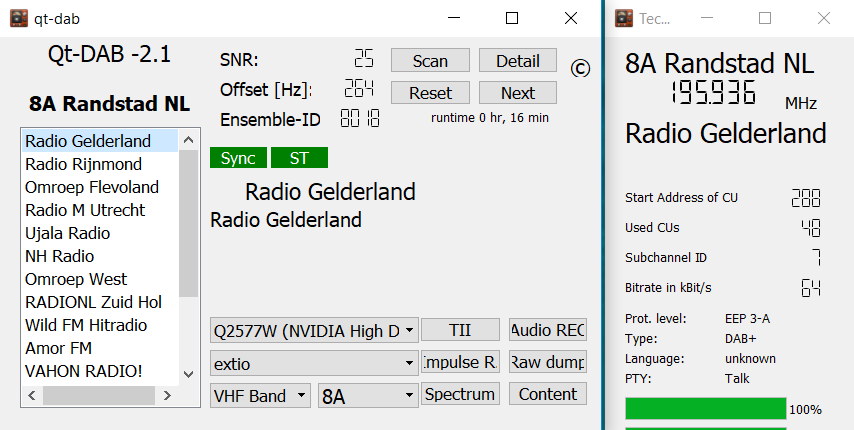
File-2 : DAB-11A.sdr -cloud.mail.ru/public/3VVR/2mvjUjKQD . Multiplex 11A at a frequency of 216.928 MHz. It contains 6 stations, with a bitrate of 48, 48, 48, 48, 64 and 48KBps, respectively.
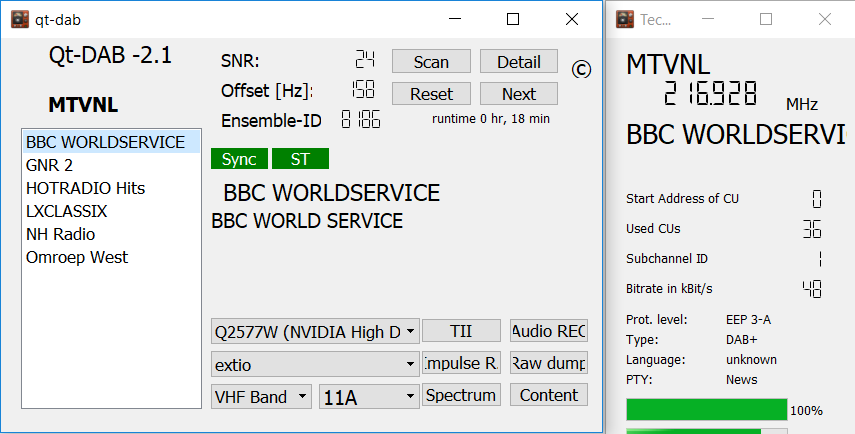
File-3 : DAB-11C.sdr - cloud.mail.ru/public/3pHT/2qM4dTK4s . Multiplex 11C at a frequency of 220.352 MHz, also contains 16 stations. The bitrates of all stations are respectively: 80, 80, 80, 80, 56, 96, 80, 64, 56, 48, 64, 64, 64, 96, 80 and 64Kbps.

As you can see, there are no problems with the number of stations, but the main problem is the low bit rate. As for the content itself, the tastes are different and I will not discuss it, anyone can download files and listen on their own. Not all multiplexes are given in the records, but the general idea, I hope, is clear.
If we talk about the prospects of digital broadcasting, then they are, alas, rather sad. The main advantage of DAB is more efficient use of the spectrum, which allows you to place more stations on the air. In this regard, DAB + makes sense only for those cities where there is no longer free space in FM. For Russia, this is probably only Moscow and St. Petersburg, in all other cities there are no such problems.
As for the sound quality, technically, DAB + can provide a bitrate of up to 192Kbit / s, which will give almost HiFi-sound. In practice, as we see above, broadcasters save and do not exceed the bar even at 100Kbit / s. Of the three multiplexes, there was only one (!) Station broadcasting in 96Kbps (and broadcasting music from 48kbps I can’t call anything but sacrilege - I need to deprive such broadcasters of a license;). So alas, we can say with 99% confidence that when switching from FM to DAB, the sound quality will be worse than it was . Of course, the situation may be better in other countries, but for example, an English review on youtube with the eloquent name Why DAB sounds so BAD. Technically, DAB is good and there are no complaints about it, but economically, "the loot defeated evil." A practical conclusion follows from this - even if the test broadcast in DAB + starts, you should not immediately go to the store for a new receiver, most likely the sound quality will be worse than in FM.
Returning to Russia, is it worth it to bother and start broadcasting in DAB? From the point of view of international prestige, probably yes, so as not to look in the eyes of neighbors a backward third-country country, and as a bonus, so that cars and radios bought in Europe can fully receive all stations. But from the point of view of listeners and sound quality, most likely users will not get any advantages in either sound quality or content quality.
Of course, DAB has its own advantages. This is a lower entry threshold (no need to buy your own transmitter), lower cost of equipment maintenance and payments for electricity (it is easier to maintain 1 multiplex transmitter than 16 independent ones). And this would be justified if there were new broadcasters creating interesting and popular content. But whether they will appear, given that we are essentially observing the era of the sunset of the radio and the departure of the audience on the Internet, is difficult to say.
If you think about the long-term prospects, then probably in the future the radio will be a device with an integrated e-sim card and a subscription toYandex musicSpotify or Apple Music upon purchase. The future is clear for streaming services and personalized content. How soon this will happen, let's see, time will tell.
In recent years, the introduction of the digital radio standard DAB + has been discussed in Russia, Ukraine and Belarus. And while in Russia the process has not yet advanced, in Ukraine and Belarus it seems that they have already switched to test broadcasting.

How does it work, what are the pros and cons, and is it needed at all? Details under the cut.
Technology
The idea of digital radio began to emerge in the late 80s, when it became clear that there was already not enough “place” in the usual FM band - in large cities the free spectrum in the 88-108 MHz band was exhausted. In this regard, DAB was considered a good alternative - it is a digital standard in which, due to more efficient coding, more stations can be placed. In the first version of DAB, the MP2 codec was used, in the second version (DAB +), the newer HE-AAC. The standard itself is very old by modern standards - the first DAB station was launched in 1995, and the DAB + station in 2007m. Moreover, the "age" of the standard in this case is even more likely plus than minus - now there is no problem buying a radio for every taste and budget.
There are quite a lot of differences between DAB and familiar FM. And the point is not that one is a “figure”, but the other is an “analogue”. The principle of content transfer is different. In FM, each station broadcasts independently, and in DAB + all stations are combined into a “multiplex”, each of which can have up to 16 stations. Different frequency channels are provided, so different countries may choose those that are free of other services.

From a business point of view, this difference causes a series of controversy among broadcasters regarding how to broadcast in a multiplex. Previously, broadcasters themselves obtained a license for the frequency, bought an antenna and a transmitter, now the license will be issued to the multiplex operator, and it will already lease channels to radio stations. It’s hard to say whether it’s better or worse, it’s more convenient for someone to have all of their own, someone is more comfortable renting.
By the way, in this regard, DAB has a huge and fat minus for the listener - the price of renting a multiplex depends on the bitrate . And if you choose between 192 and 64kbps ... I think everyone understands what will be chosen. If broadcasting with poor quality in FM is rather difficult, then in DAB it is even encouraged economically (it is clear that this is not the fault of the developers of the standard, but nonetheless). Russian prices are, of course, unknown, and English for an example, you can see here .
From a technical point of view, the DAB + multiplex is a broadband signal with a spectrum width of the order of 1.5 MHz, which is clearly visible using an RTL-SDR receiver.

A more detailed description in PDF can be found here .
Competing Standards
In general, there are not so many of them. In Europe, DAB + is used, in the USA the HD Radio standard is popular , in India they conducted experiments with the DRM standard , but it's hard to say how they ended.
The map is a bit outdated (DRM was also tested in Russia, but it was abandoned), but the general idea can be understood:

Source
Unlike DAB, the creators of the HD Radio standard took a different path - the digital signal is placed directly next to the analog one, which allows broadcasters to use their own antennas and masts.

However, this does not solve the problem, because of which it all began - the problem of the lack of empty seats in the spectrum. Yes, and purely geographically (and probably politically), in ex-CIS countries, the adoption of a European standard looks more logical than using the American standard - the choice of European goods is still more and it is easier to buy receivers. In 2011, there were still references to the Russian RAVIS standard , but it all died out (and thank God, because its own digital standard is incompatible with anything, this is the worst that could have been invented for radio listeners).
Testing
Finally, we turn to the practical part, i.e. to testing. In Russia, DAB does not work yet, so we will use SDR records from the Dutch multiplex. Those interested from other countries can also join and send me records in IQ format, I will process them and make a summary table.
How can you listen to DAB at all? Because digital standard, then you can decode it using a computer and rtl-sdr receiver. There are two programs - qt-dab and Welle.io , both can work with rtl-sdr.
Qt-dab looks like a student’s term paper, and the author clearly didn’t bother with design - fonts do not fit into controls, windows do not scale. But for us, the most important thing is that it allows you to read and write IQ files.

Welle.ioIt’s still in beta, but it works much better and decodes better. It is also possible to display quite a lot of additional debugging information:

But welle.io is not yet able to work with iq-files, so we will use Qt-dab.
For testing, I uploaded 3 files to cloud.mail.ru, each one contains a minute record of the DAB multiplex, the file size is about 500 MB (this is the size of IQ records for SDR with a 2.4 MHz bandwidth). You can open files in Qt-dab, the download link of which is given above.
File-1 : DAB-8A.sdr - cloud.mail.ru/public/97hr/2QjuURtDq . Multiplex 8A operates at a frequency of 195.136 MHz and contains 16 stations. The bit rate of all stations is 64Kbps.

File-2 : DAB-11A.sdr -cloud.mail.ru/public/3VVR/2mvjUjKQD . Multiplex 11A at a frequency of 216.928 MHz. It contains 6 stations, with a bitrate of 48, 48, 48, 48, 64 and 48KBps, respectively.

File-3 : DAB-11C.sdr - cloud.mail.ru/public/3pHT/2qM4dTK4s . Multiplex 11C at a frequency of 220.352 MHz, also contains 16 stations. The bitrates of all stations are respectively: 80, 80, 80, 80, 56, 96, 80, 64, 56, 48, 64, 64, 64, 96, 80 and 64Kbps.

As you can see, there are no problems with the number of stations, but the main problem is the low bit rate. As for the content itself, the tastes are different and I will not discuss it, anyone can download files and listen on their own. Not all multiplexes are given in the records, but the general idea, I hope, is clear.
conclusions
If we talk about the prospects of digital broadcasting, then they are, alas, rather sad. The main advantage of DAB is more efficient use of the spectrum, which allows you to place more stations on the air. In this regard, DAB + makes sense only for those cities where there is no longer free space in FM. For Russia, this is probably only Moscow and St. Petersburg, in all other cities there are no such problems.
As for the sound quality, technically, DAB + can provide a bitrate of up to 192Kbit / s, which will give almost HiFi-sound. In practice, as we see above, broadcasters save and do not exceed the bar even at 100Kbit / s. Of the three multiplexes, there was only one (!) Station broadcasting in 96Kbps (and broadcasting music from 48kbps I can’t call anything but sacrilege - I need to deprive such broadcasters of a license;). So alas, we can say with 99% confidence that when switching from FM to DAB, the sound quality will be worse than it was . Of course, the situation may be better in other countries, but for example, an English review on youtube with the eloquent name Why DAB sounds so BAD. Technically, DAB is good and there are no complaints about it, but economically, "the loot defeated evil." A practical conclusion follows from this - even if the test broadcast in DAB + starts, you should not immediately go to the store for a new receiver, most likely the sound quality will be worse than in FM.
Returning to Russia, is it worth it to bother and start broadcasting in DAB? From the point of view of international prestige, probably yes, so as not to look in the eyes of neighbors a backward third-country country, and as a bonus, so that cars and radios bought in Europe can fully receive all stations. But from the point of view of listeners and sound quality, most likely users will not get any advantages in either sound quality or content quality.
Of course, DAB has its own advantages. This is a lower entry threshold (no need to buy your own transmitter), lower cost of equipment maintenance and payments for electricity (it is easier to maintain 1 multiplex transmitter than 16 independent ones). And this would be justified if there were new broadcasters creating interesting and popular content. But whether they will appear, given that we are essentially observing the era of the sunset of the radio and the departure of the audience on the Internet, is difficult to say.
If you think about the long-term prospects, then probably in the future the radio will be a device with an integrated e-sim card and a subscription to
